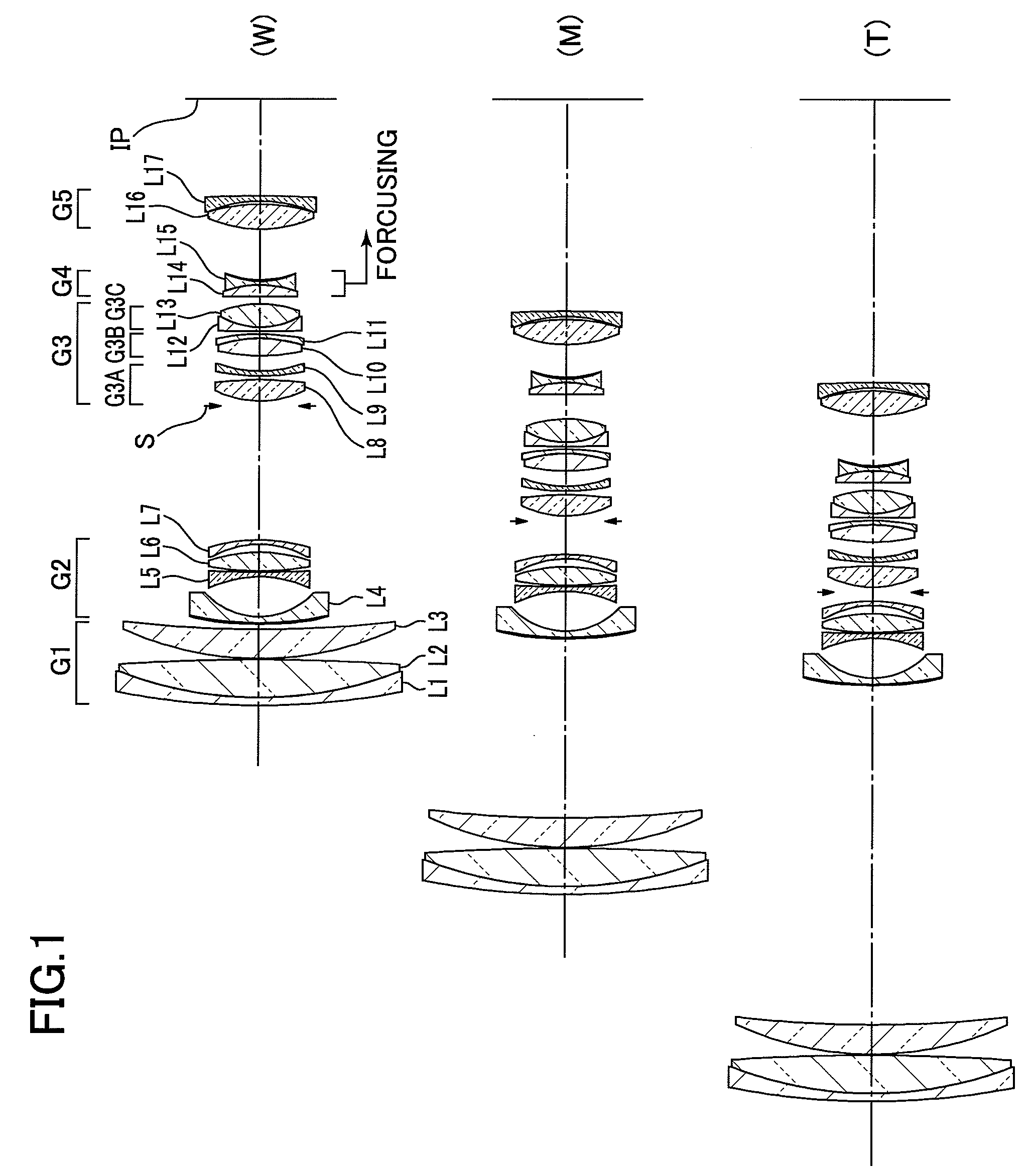Enhanced variable power zoom lens
a variable power and zoom lens technology, applied in the field of compact and enhanced variable power zoom lenses, can solve the problems of user's hands shaking during photographing, difficult to achieve instantaneous focusing, etc., and achieve the effect of reducing aberration
- Summary
- Abstract
- Description
- Claims
- Application Information
AI Technical Summary
Benefits of technology
Problems solved by technology
Method used
Image
Examples
embodiment 1
[0078]A first embodiment of an enhanced variable power zoom lens consists of the foremost or first lens group G1 of positive refractivity, the second lens group G2 of negative refractivity, the third lens group G3 of positive refractivity, the fourth lens group G4 of negative refractivity, and the fifth lens group G5 of positive refractivity arranged in sequence from a position closer to the object.
[0079]The first lens group G1 consists of a composite lens of a negative meniscus lens piece L1 having its convex surface directed toward the object and a double-convex lens piece L2, and a positive meniscus lens L3 having its convex surface directed toward the object.
[0080]The second lens group G2 consists of a negative meniscus lens L4 having its convex surface directed toward the object, a double-concave lens L5, a double-convex lens L6, and a negative meniscus lens L7 having its convex surface directed toward the image plane. The negative meniscus lens L4 positioned the closest to the...
embodiment 2
[0095]A second embodiment of the enhanced variable power zoom lens according to the present invention consists of the foremost or first lens group G1 of positive refractivity, the second lens group G2 of negative refractivity, the third lens group G3 of positive refractivity, the fourth lens group G4 of negative refractivity, and the fifth lens group G5 of negative refractivity arranged in sequence from a position closer to the object.
[0096]The first lens group G1 consists of a composite lens of a negative meniscus lens piece L1 having its convex surface directed toward the object and a double-convex lens piece L2, and a positive meniscus lens L3 having its convex surface directed toward the object.
[0097]The second lens group G2 consists of a negative meniscus lens L4 having its convex surface directed toward the object, a double-concave lens L5, a double-convex lens L6, and a negative meniscus lens L7 having its convex surface directed toward the image plane arranged in sequence fr...
embodiment 3
[0113]A third embodiment of the enhanced variable power zoom lens according to the present invention consists of the foremost or first lens group G1 of positive refractivity, the second lens group G2 of negative refractivity, the third lens group G3 of positive refractivity, the fourth lens group G4 of negative refractivity, and the fifth lens group G5 of positive refractivity arranged in sequence from a position closer to the object.
[0114]The first lens group G1 consists of a composite lens of a negative meniscus lens piece L1 having its convex surface directed toward the object and a double-convex lens piece L2, and a positive meniscus lens L3 having its convex surface directed toward the object.
[0115]The second lens group G2 consists of a negative meniscus lens L4 having its convex surface directed toward the object, a negative meniscus lens L5 having its convex surface directed toward the image plane, a double-convex lens L6, and a negative meniscus lens L7 having its convex sur...
PUM
 Login to View More
Login to View More Abstract
Description
Claims
Application Information
 Login to View More
Login to View More - R&D
- Intellectual Property
- Life Sciences
- Materials
- Tech Scout
- Unparalleled Data Quality
- Higher Quality Content
- 60% Fewer Hallucinations
Browse by: Latest US Patents, China's latest patents, Technical Efficacy Thesaurus, Application Domain, Technology Topic, Popular Technical Reports.
© 2025 PatSnap. All rights reserved.Legal|Privacy policy|Modern Slavery Act Transparency Statement|Sitemap|About US| Contact US: help@patsnap.com



